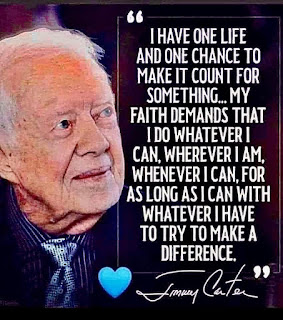This is Part 2 in a series exploring behaviors that can help increase an individual's sense of well-being. Throughout this series, we will answer the questions:
- What does it truly mean to be happy?
- What are some ways that we can increase our own happiness, and that of our students?
We will answer these questions through the lens of different "keys" to well-being such as meaning and purpose, flow and peak performance, compassion and empathy, religion and spirituality, stress and coping, physical health, and forgiveness among others. For each topic, we will define what is meant by each "key to well-being," explore the research, and identify specific interventions to increase well-being. In this post, we will be looking at the importance of meaning and purpose.Finding Meaning
In my last post, we learned that a significant percentage (up to 40%) of our well-being is within our own control. For your homework, I asked you to
Think about the world around you. The good, the bad, the ugly. If you could wave a magic wand and change anything about the world, what would you change? Why? What can you do today to make the world a little bit better in this area?
If you missed out on the last post, take a moment to think about this question before reading on.
Meaning → Purpose
A sense of meaning is an important predictor of well-being. It is positively correlated with positive emotions like happiness and joy. It acts as a protective factor against stress. It is predictive of healthier behaviors and outcomes (Compton, 2020, p. 312). But just what is "meaning" and how do we build it?
For the purpose of this post, Meaning is WHY we do what we do. It is our understanding of our world. It is defined by our beliefs, values, and sense of order governing our existence. It is as unique to us as our fingerprints. It is rooted in our thoughts, feelings, and experiences. Purpose is WHAT we do. It is goal-oriented. It is the impact that we want to have based on our meaning. Unsurprisingly, we experience the greatest amount of well-being when meaning and purpose are in alignment.
Our sense of meaning, and the purpose that we construe from it, is continually evolving. It continues to change and develop over the entirety of our lives. PURPOSE is a PROCESS, not a PRODUCT.
Creating Meaning = Purpose + Significance
According to Martin Seligman, to be authentically happy we must use our " signature strengths in the service of something larger and more significant than the individual self. It involves going beyond individual concerns to take a wider perspective on life" (Compton, 2020, p. 60). I absolutely love this quote! Here's why. He states that we must use our STRENGTHS in service of something. Each of us has unique strengths and talents that are uniquely suited for a certain task or purpose. Research has shown that understanding and applying character strengths can boost confidence, strengthen relationships, reduce stress, and improve performance. Plus, we are just happier when we are using our strengths, especially in a way that serves a purpose that is larger than the individual self.
One way to identify our strengths is the Values in Action Strength Inventory. The VIA is a personality inventory that will help you identify your greatest strengths. In addition, it classifies your strengths into six core virtues; (1) Wisdom and Knowledge, (2) Courage, (3) Humanity, (4) Justice, (5) Temperance, and (6) Transcendence. In my next post, we will take a closer look at how our purpose is shaped by a "greater good."
Until then, I would like you to do a little homework for me. This would also be a great activity to do with your students! For this activity, you will create a "life list" and use this list to define your purpose. Then, you will identify your strengths and virtues and reflect on how they can be seen in your life. You can access the activity by clicking on the link "What's Your Purpose?" below.
Each year I begin my class by asking my students to write down a story from when they were "at their best" and identify their strengths using the VIA Inventory. This past year, I noticed that a student had his head down during the activity. I discreetly checked in with him to make sure he was okay. What he said to me shook me to the core. He told me that he didn’t have anything to write. He didn’t feel like he had a single moment to be proud of. He said he didn’t have any strengths.
My heart broke. I told him he was in the right place. We were going to work together to find his passions, his purpose, and his path forward. That is my hope for all of my students. I want them to leave my class with a better understanding of themselves and the world around them. I want to equip them with the tools they need to navigate times of triumph, times of despair and every time in-between. Finding meaning and purpose in life is an essential piece of the well-being puzzle. In my next post, we will look at the relationship between spirituality and well-being.
Be Well,
Cori
Resources:
Compton, W. C., & Hoffman, E. (2020). Positive psychology: The science of happiness and flourishing. third edition. Sage.
Lyubomirsky, S. (2013). The how of happiness: A practical guide to getting the life you want. Piatkus.
Miller, C. A., & Frisch, M. B. (2011). Creating your best life: The ultimate life list guide. Sterling.
.jpg)



Comments
Post a Comment